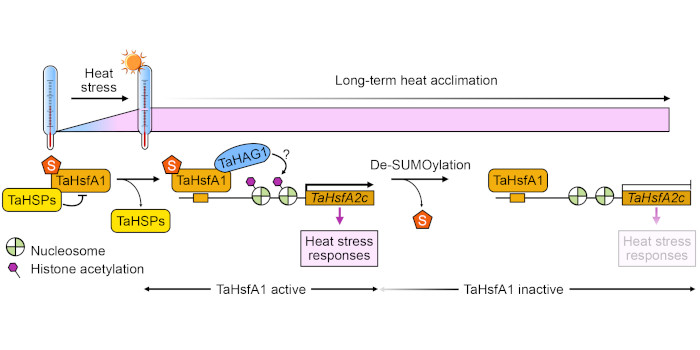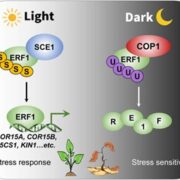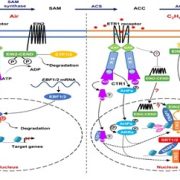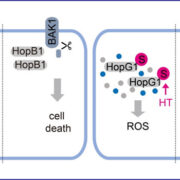The Molecular Switch Governing the Heat Stress Response in Wheat
Wang et al. explore how SUMOylation of a key transcription factor affects heat stress responses in wheat.
https://doi.org/10.1093/plcell/koad192
By Jie Liu and Haoran Wang; Frontiers Science Center for Molecular Design Breeding, Key Laboratory of Crop Heterosis and Utilization (MOE), Beijing Key Laboratory of Crop Genetic Improvement, College of Agronomy and Biotechnology, China Agricultural University, Beijing 100193, China
Background: In response to high temperature, plants use transcription factors to initiate protective responses; as they acclimate to extended high temperature, the plants then turn off these rapid responses. The heat shock-associated transcription factor HsfA1 plays a central role in sensing heat stress and promoting rapid transcriptional responses. At normal temperatures, HsfA1 is associated with heat shock proteins such as HSP70 and HSP90, which repress its protein activity; at high temperature, these proteins rapidly release HsfA1 to initiate heat stress responses. In addition to this well-known OFF-to-ON switch for HsfA1 activity, additional ON-to-OFF mechanisms must exist to complete the HsfA1 cycle during acclimation to long-term heat stress. Here we explored how the ON/OFF molecular regulation of HsfA1 activity occurs in wheat (Triticum aestivum).
Question: How is the transcriptional activation activity of HsfA1 regulated when it is released from multichaperone repression complexes during prolonged periods of high temperatures?
Findings: Genetic evidence revealed that TaHsfA1 is required for basal and acquired thermotolerance as well as normal heat-induced transcriptional reprogramming in wheat. TaHsfA1 is modified by the small peptide SUMO predominantly at its 459th amino acid (lysine, K459). SUMOylated TaHsfA1 proteins were detected at the early stage of heat stress treatment, but their levels decreased upon prolonged thermal stress. Consistent with these observations, heat stress–responsive genes were highly induced at the beginning of heat shock but were downregulated and returned to basal expression levels during long-term thermal stress. These findings support a role for the thermosensitive SUMOylation of TaHsfA1 in controlling TaHsfA1 activity and dynamic heat stress responses at different stages of thermal stress.
 Next steps: We plan to introduce the K459-mutated (non-SUMOylated) form of TaHsfA1 into wheat Tahsfa1 mutants to evaluate the importance of TaHsfA1 SUMOylation in sensing heat stress and regulating responses in cereal crops. In addition, we plan to look for the protein components responsible for TaHsfA1 de-SUMOylation during long-term thermal stress.
Next steps: We plan to introduce the K459-mutated (non-SUMOylated) form of TaHsfA1 into wheat Tahsfa1 mutants to evaluate the importance of TaHsfA1 SUMOylation in sensing heat stress and regulating responses in cereal crops. In addition, we plan to look for the protein components responsible for TaHsfA1 de-SUMOylation during long-term thermal stress.
Reference:
Haoran Wang, Man Feng, Yujie Jiang, Dejie Du, Chaoqun Dong, Zhaoheng Zhang, Wenxi Wang, Jing Liu, Xiangqing Liu, Sufang Li, Yongming Chen, Weilong Guo, Mingming Xin, Yingyin Yao, Zhongfu Ni, Qixin Sun, Huiru Peng and Jie Liu. (2023). Thermosensitive SUMOylation of TaHsfA1 defines a dynamic ON/OFF molecular switch for the heat stress response in wheat https://doi.org/10.1093/plcell/koad192






